Ankita Raturi. Agricultural Informatics Lab. Purdue University.
The Locavorian Challenge
Global crises, such as the ongoing COVID-19 pandemic, highlight the fragility of our local food system. Farmers and consumers are faced with challenges around coordinating food production and distribution. Disruptions in global and local supply chains demand that communities take creative approaches to ensure community food resilience. The ramifications of a pandemic-based disruption to local food systems include: labor shortages as workers fall ill; a shift in consumer preferences toward online purchasing and curbside pickup; reduced traffic and cancellation of farmers’ markets due social distancing; panic planting of “Victory” gardens similar to those seen during World War II; unequal access to healthy foods as Electronic Benefits Transfer and alternative forms of payment are limited via online point of sales tools; and increases in food waste as farmers lose access to traditional distribution channels.
Ensuring both long and short term community food resilience requires urgent research to understand, design, and develop technology mediated systems to coordinate the local production and distribution of fresh produce, meats, and processed foods, within a community.
Jump to: Proposed Approach, Join the Conversation
Technology Landscape
In response to supply chain disruptions occasioned by the COVID-19 pandemic and the effects of social distancing on traditional distribution channels (e.g., on-farm markets, CSA pickups, farmers’ markets), farmers and consumers to look to Internet-based solutions to ensure that operations continue. To better understand challenges in a forced, rapid transition to online platforms, we have conducted a preliminary review of 25 digital tools (list available at request). There are four genres of tools — online store fronts, online farmers’ markets, farm directories, and social media — each rife with opportunities and challenges (summarized in Table 1).
Please note: some examples are Indiana-specific as this document was originally written for a local audience!
1. Online store fronts: A common starting point for many farms, even those with no prior online presence. Those who already utilize online payment services such as Square and can utilize the service’s web-based storefront. This restricts farmers to the payment service itself with limited flexibility for alternative payment options and the potential of vendor lock-in. Tools like Harvie provide a web interface for consumers to sign up for Community Supported Agriculture (CSA) shares at specific farms. It is however limited in functionality and locks you into a specific distribution method. CSA management, especially during a pandemic, is further complicated by distribution logistics and requires, as always, an engaged community. Finally, tools like Barn2Door and Local Food MarketPlace offer farmers the ability to simply set up an online store front. However, farmers already use a range of mechanisms to track inventory and sales data, from paper-based log books, custom pick and pack software, financial tools (e.g., Square, Quickbooks), and digital record keeping tools (e.g., FarmOS and FarmLogs), among others. This means that getting “online”, whether into a storefront or an online farmers’ market (as discussed next), is not always a straightforward process and can entail a time consuming effort to aggregate appropriate data into a particular system.
2. Online farmers’ markets: With the rise of tools like Instacart and Amazon Prime Now for grocery store delivery, we find there is increased consumer interest in online aggregation tools that offer the ability to buy from small, independent, food producers while providing a farmers’ market experience online. For instance, Hoosier Harvest Market is a farmer-owned cooperative with an online sales experience that allows consumers to shop from a selection of local farms. While an excellent model, the primary bottleneck involves the requirement for an engaged community willing to coordinate distribution. In the case of Hoosier Harvest Market for instance, it means that there are limited pickups in Indiana, all of which are in a small region west of Indianapolis. Market Wagon, also an online farmers’ market, aims to serve local communities and handles distribution logistics. Majority of their available foods are meats, dairy products, and value-added goods. There are many other tools for online farmers’ markets. For instance, there is Crave, a customizable mobile application for farmers’ market coordinators to complement their in-person markets with an online presence. Consider also: Local Orbit, an open source tool which offers food hubs and suppliers the ability to host and run their own online platform with a targeted community. The Open Food Network is another open platform that aims to connect local suppliers, distributors, and consumers within a community. Given the plethora of options, the critical question is: why is there a lack of farmer participation and availability of fresh produce in online farmers’ markets?
3. Farm directories: There is a long tradition of maintaining farm directories to offer consumers and other food system stakeholders with access to a range of goods and services provided by local farmers. Federal and state run directories, such as USDA AMS Local Food Directory and Indiana Grown respectively, list farms and food producers in different geographic regions, and further categorize them, in the case of the AMS directory by sales method: directory farmers’ markets, CSA shares, on-farm markets. These listings can contain rich farm information including whether or not the market participates in Federal nutrition programs (e.g, SNAP). To complement these, communities are beginning to put together county-based, or local area directories, often in the form of crowd-sourced spreadsheets, and sometimes include a rudimentary web-interface to view the data. However, the data curation process does not lend itself to a dynamic food system with changing participants, services, and products, nor does it lend itself well to consumer farm-discovery or purchasing.
4. Social media: Many farms already maintain a presence on social media, most popularly on Facebook and Instagram. These are primarily used as marketing tools to attract consumers to particular in-person deals, appearances at farmers’ markets and other special events, as well as for consumer education on agriculture. Though many social media platforms offer minimal e-commerce capabilities, the limited functionality is not conducive to a dynamic and diverse inventory common to diversified food and farming systems.
The questions remain: What are the barriers that farmers and consumers face in coordinating local food production and distribution? More urgently, how can we enable community food resilience through appropriate digital technologies and technology mediated processes?
| Table 1. Challenges of the Technology Landscape: Summary |
|---|
| Online storefronts: getting “online”, whether into a storefront or an online farmers’ market (as discussed next), is not a straightforward process and can entail a time consuming effort to aggregate appropriate data into a particular system. |
| Online farmers’ markets: while there are many technology options, there is a lack of farmer participation and availability of fresh produce in online farmers’ markets and other food aggregators. |
| Farm directories: the data curation process does not lend itself to a dynamic food system with changing participants, services, and products, nor does it lend itself well to consumer farm-discovery or purchasing. |
| Social media: though many social media platforms have begun to offer minimal e-commerce capabilities, their limited functionality is not conducive to a dynamic and diverse inventory common to diversified food and farming systems. |
Proposed Approach
Our short term goal is to design, refine, and assemble a set of tools and processes for farmers and consumers for local coordination of food production and distribution. In the long term, our aim is to improve community food resilience by making sure that farmers are able to provide for demand at the community-level for locally produced, high quality, foods, from field crop food staples, livestock products, fresh produce, and value added goods.
The first three objectives below are geared toward accomplishing our short term goal. The final objective is to serve as a bridge between meeting urgent community needs and setting up for longer term resiliency. We are seeking ongoing community (farmers, developers, researchers) input on feasibility, urgency, and feature prioritization, to increase granularity of the objectives and adjust timing.
- Understanding roadblocks in the community food landscape. Farmer-focused qualitative study, consumer-focused food flow mapping, and an evaluation of the technology landscape.
- Farmer-centered and community-driven design of local food tool kits. Create design artifacts to allow groups to create a farmer triage process, a community mobilization process, and appropriate technologies for community coordination.
- Rapid prototyping and community testing of critical processes and technologies. Build out and setup the necessary social and technical infrastructure for farmers, consumers, community coordinators, and technology stewards to get things in motion!
- Strategizing longer term community food resilience: Thinking beyond COVID-19 response, consider how we can ensure continuity of community food systems, availability of technologies and support, and pathways for collaboration.
Objective 1 (Current Phase)
Understanding roadblocks in the community food landscape: First, we need to articulate key information challenges faced by small scale diversified farmers in the United States. The Agricultural Informatics Lab will lead a brief qualitative study consisting of in-depth semi-structured interviews to map the flow of information from “seed to market”. Through a community driven effort, we can quickly articulate current consumer pathways to food. Finally, given the variety of digital technologies available, we will, in collaboration with the GOAT community, conduct a functional evaluation of digital technologies to better inform subsequent design and development activities. These activities are detailed in the three figures below.
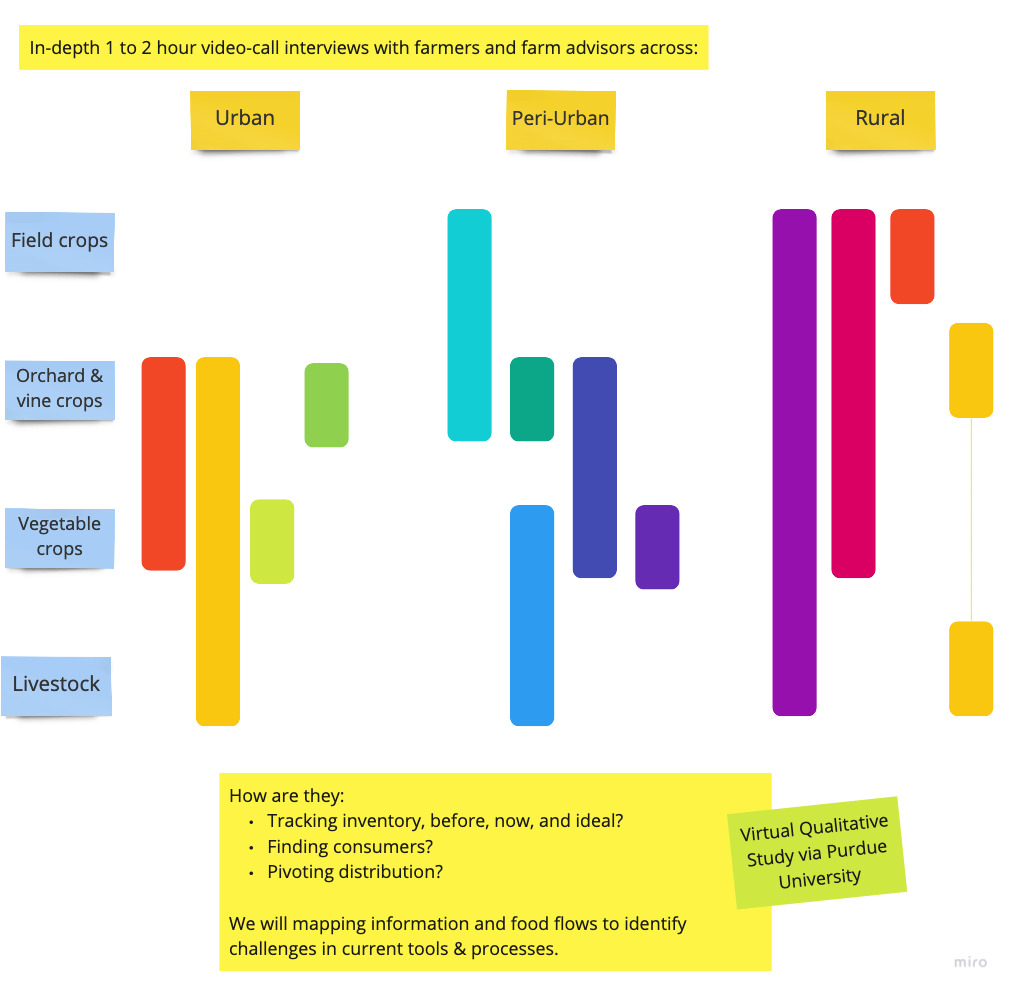
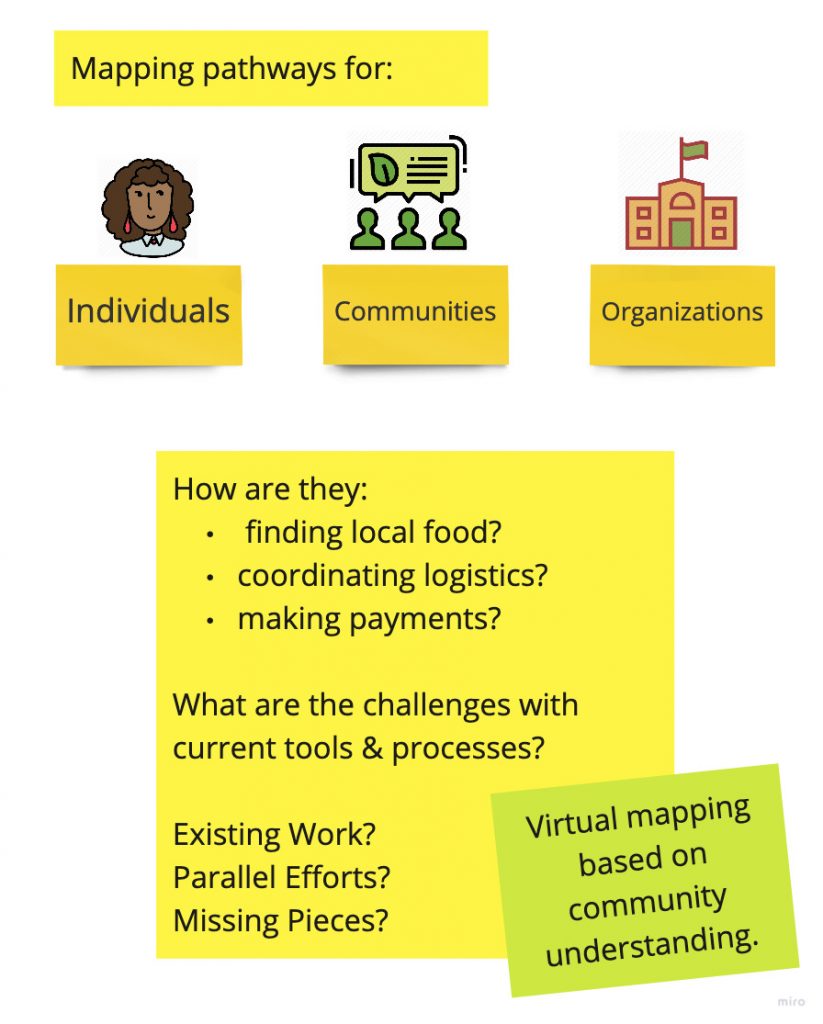
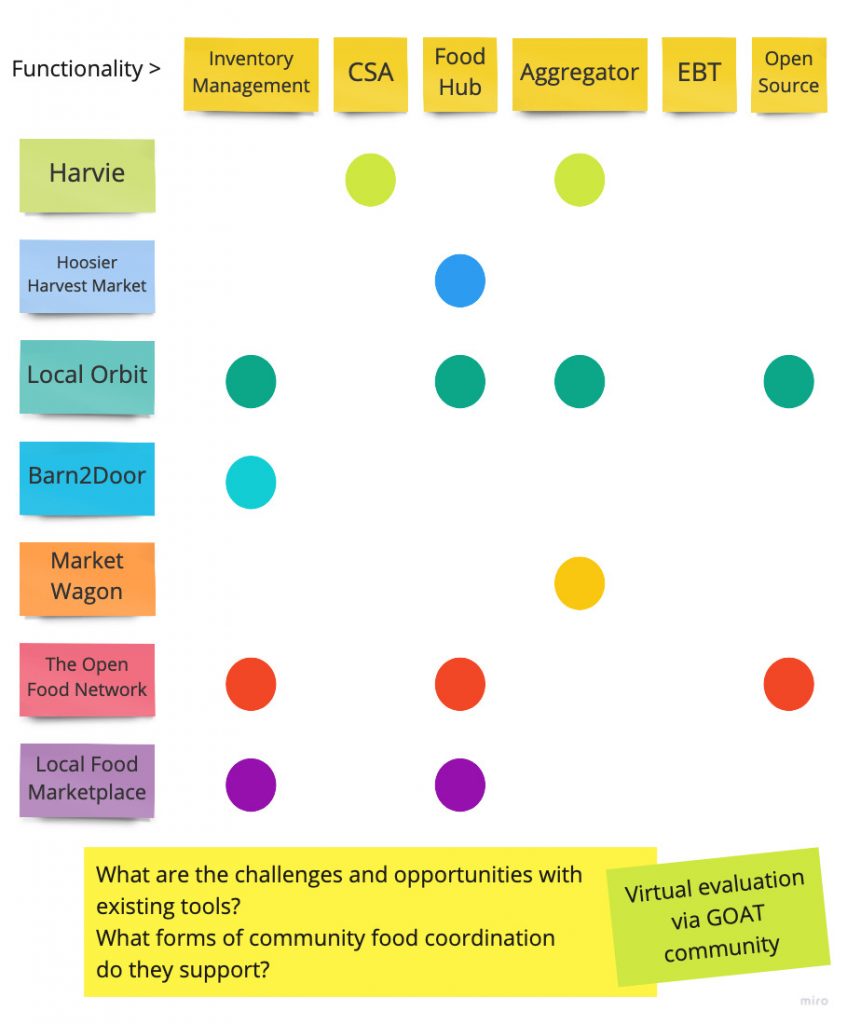
Objective 2
Farmer-centered and community-driven design of local food tool kits: Through collaboration with farmers, consumers, and community members, we will engage in participatory prototyping and design of digital tools and coordination strategies that empower community members to engage in their local food system. The following activities would be conducted by small, focused teams working concurrently to design portions of a local food toolkit:
- Design add-on features to existing tools and modular open source tools for desired, as yet unavailable, functionality. This work entails the specification of farmer information management needs for implementation by technology developers in Objective 3.
- Design a triage process to be conducted by a “response” team consisting of local extension educators paired with technical support community members. This triage process must detail how extension educators or farm coordinators can assess a specific farm’s technology needs and capacity, and shepherd them through the process of getting online, with support of technical community members. This work may require additional tooling to be built in Objective 3.
- Design a community mobilization process to empower consumers to form community food hubs to utilize farm aggregation tools. This process should empower like minded consumers to find each other, identify a local farm or market that meets their collective needs, and coordinate distribution and other logistics as needed. This work may require additional tooling to be built in Objective 3.
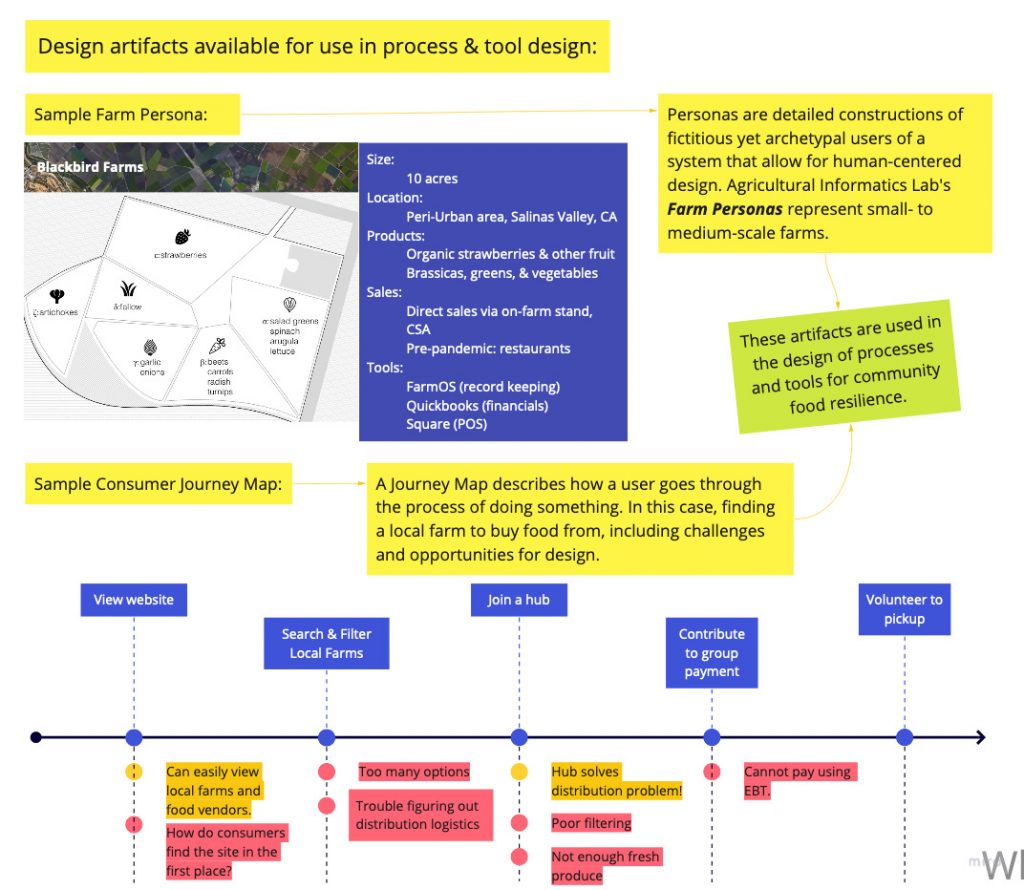
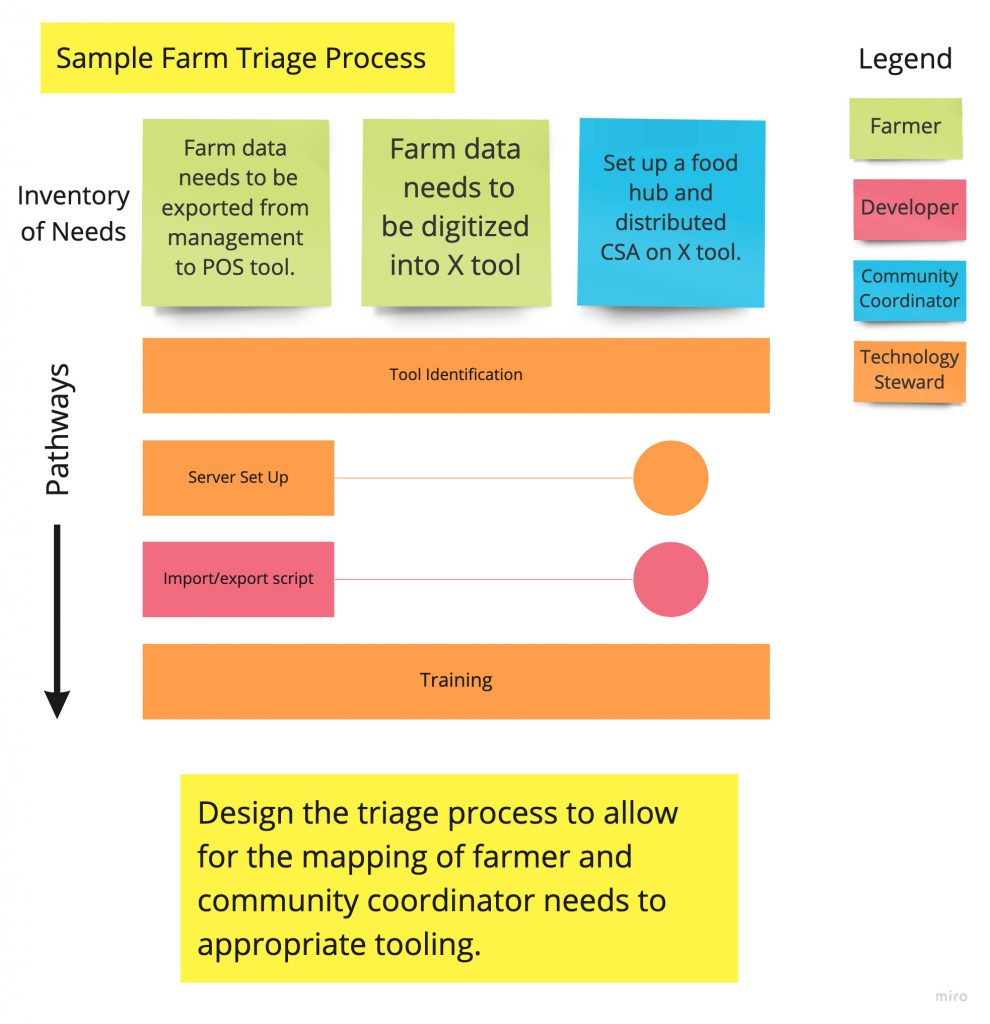
Objective 3
Rapid prototyping and community testing of critical processes and technologies: Using a modified design sprint method design we have developed at the Agricultural Informatics Lab, we will transition from concept to prototypes for use by farmers and consumers in local communities. We anticipate this work will include partnering with existing university, industry, and community partners engaged in local food technology development efforts.
- Begin with a one week development sprint, to enable development of the processes and tools designed in the previous objective.
- Alpha deployment of processes and tools within 3-4 communities for initial testing, use, and feedback.
- Two-week sprints for iterative refinement and deployment of community food coordination processes and tools, with continual improvement through open source development methods.
Objective 4
Strategizing longer term community food resilience: Disruptions to a local food system can take many forms; COVID-19 happens to be our most recent, ongoing, and significant challenge. This particular crisis introduces major challenges in local food production and distribution, which if addressed in the short term, connects consumers and producers. In the longer term, similar strategies can serve as the foundation for longer term planning and capacity building for enhanced community food resilience.
Our Virtual Research Capacity & Prior Experience
- Agricultural data gathering: Currently my team is assembling cover crop data with the Northeastern Cover Crops Council. We virtually work with 5 groups crosscutting 15 states, each consisting of 4-10 people farmers, extension educators, researchers, and developers.
- Human-centered design: In March 2020, I co-organized a virtual 3-day human-centered design session for the Open Technology Ecosystem for Agricultural Management with approximately 40 participants across the United States on design for on-farm soil health data collection.
- Rapid prototyping: I lead a virtual distributed development team across 4 states in the design and development of a suite of Cover Crop tools. Last November, we successfully conducted a virtual design sprint and have subsequently developed a Cover Crop Species Selection Tool.
- Gathering for Open Agricultural Technology: GOAT is a grassroots online community of farmers, developers, designers, and researchers interested in the development of open source technologies for community food systems. I have served as co-founder and organizer since 2018.
Call for Participation
We seek to support coordination and collaboration among food producers and consumers within our communities, both during the COVID-19 pandemic, and beyond. Our work is on Informatics for Community Food Resilience, where we take a farmer-centered and community-driven approach to the design of processes and digital technologies. We’re looking for: farmers, advisors, educators, and researchers to guide what we design and build. You can also join our team if you are a designer, developer, writer, locavore, or community organizer.
If you’d like to learn more you can also contact Ankita Raturi (ankita@purdue.edu) or Juliet Norton (jnnorton@purdue.edu) for more information.
Join the conversation!
Want to learn more our work and attend community calls?